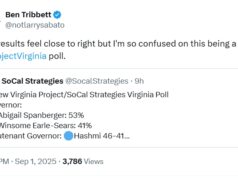( – promoted by lowkell)
Don’t forget to take the poll at the end on your least favorite part of the Republican gerrymander!
On the first day of Christmas, the Commonwealth of Virginia gave to me …
A Republican gerrymander in the House of Delegates that is the excuse for everything that goes wrong?
It may seem as exciting as a lump of coal, but the Republican gerrymander in the House of Delegates gets a lot of attention from thankful Virginia Democrats. Why? Because these district lines have become the perfect excuse for the terrible, horrible, no good, very bad performance of House Democrats in 2013.
Manage to pick up only one seat, on net, in the House of Delegates? No worries, blame the Republican gerrymander!
A total of 14 Barack Obama-won delegate districts still held by Republicans, and 16 won by Tim Kaine? Mumble mumble, gerrymandering …
Terry McAuliffe won 11 delegate districts held by Republican Delegates, and Mark Herring still won 9, but .. Look over there, it’s a gerrymander! Run for your lives!
I am not a fan of the use of the gerrymander as a crutch, but in the spirit of Christmas I will concede that it is a contributing factor to the difficulties of House Democrats. It’s true, the lines have been drawn to frustrate and isolate Virginia Democrats.
But a comparison with their peers in the State Senate also shows deeper concerns for Virginia Democrats.
Over in the State Senate, with a Democratic gerrymander, there are 19 state senate districts held by Democrats won by Barack Obama in 2012 (pending two special election, good luck!). There are two more marginally Obama districts held by Republicans (7th, Wagner; and 10th, Watkins), and another one won by Tim Kaine (17th, Reeves).
But there’s a Democratic cliff after the 21st (Edwards). In the 21st and all other Democratic held state senate districts, Barack Obama received over 54% of the vote in 2012. The next most Democratic district, the 10th, was only 50.41% for Obama. Watch out below, that’s a steep drop!
Senate Democrats had no way of knowing how the 2012 election would end up, so we should look at 2008. They drew a slate of 19 districts where Obama won over 55% of the vote (he declined slightly in the Roanoke-based 21st in 2012). They then had a handful of marginal districts (10th, Watkins; 17th, Reeves; 13th, Black; 20th, Stanley; and 7th, Wagner). But there’s a big gap between the 55%+ districts and the competitive ones.
You’d think if you’re going to gerrymander a chamber, you’d at least ensure that you’d be able to get to a majority (21 seats) or split control (20 seats) with more solidly Democratic seats. Democrats tried with their first map (drawing a safely Democratic 8th District in the Richmond area, and a more competitive 7th in Virginia Beach), but that got shot down as too partisan by Governor Bob McDonnell. Hah! That map probably would have created 21 safely Democratic seats, plus any upside from keeping around Puckett, Houck, and Reynolds. If only that has passed. But remember this Democratic cliff in the State Senate during 2015, it’s a big concern if Puckett retires or is defeated …
Over in the House of Delegates, Republican drew a gerrymander that packed Democrats into 55%+ Obama districts (notice how both parties agree that it takes a 55% Obama seat to be a safely Democratic seat). There are only two Republican delegates representing districts that are this Democratic in 2012: Rust (86th) and Ramadan (87th). These are also the only two Republican held districts where McAuliffe won over 55% of the vote. All other “Obama” Republican districts occupy the same stretch of plurality to under 55% performance, the same hostile terrain that Senate Democrats have struggled with.
Our two pickups in the House of Delegates, Futrell in the 2nd and Mason in the 93rd, are both districts where Obama won over 55% of the vote. A very strong Democratic turnout put McAuliffe over 55% in the 93rd, and Mason was able to hold on despite running behind the top of the ticket. The 2nd district in Prince William is a good district for Democrats to analyze for the future. McAuliffe won just over 50%, but the turnout was high enough for Futrell to win with a very strong campaign focused on Democratic voters. How was Futrell able to hang on and win while other Democratic candidates fell short?
What’s the difference between House Democrats and Senate Democrats? The former have been screwed in redistricting, but both have failed to find ways to win in less than overwhelmingly Democratic districts. Right now, Republicans in the General Assembly simply outcompete and outperform their Democratic opponents among the narrow sliver of swing voters in most competitive districts. So enjoy that gerrymander this Christmas season, it helps hide deeper problems facing Virginia Democrats in both branches of the General Assembly!
Here’s a resolution for the New Year, let’s work on improving Democratic campaigns in competitive districts. Remember this the next time someone talks about “Obama” or “Kaine” districts. Also remember it within the context of the Republican-held districts that Terry McAuliffe won. The Democratic Delegates are clustered in the over 55% McAuliffe districts, with two exceptions: Futrell in the 2nd, and the soon-to-be-vacant 100th district in the Eastern Shore. In the 100th, McAuliffe won with less than 50% of the vote, and Obenshain defeated Herring. Democrats have struggled in these sorts of districts, the current approach to campaigning won’t win this seat back if Republicans take it in the special election. It may be a rough January …
[poll id=”
121
“]














